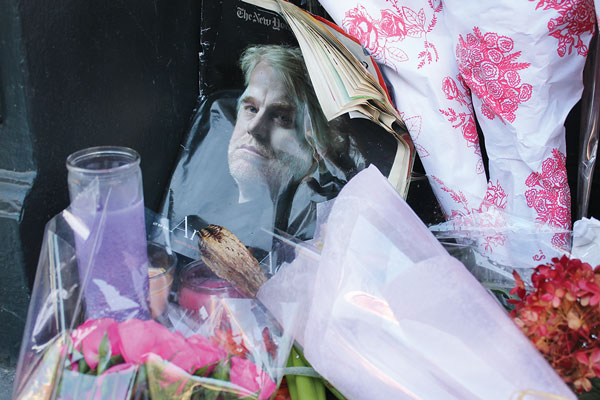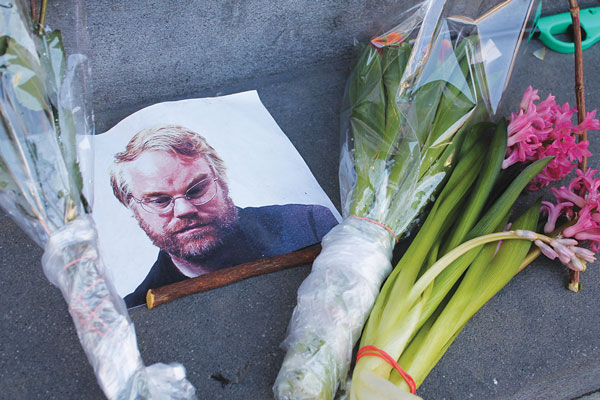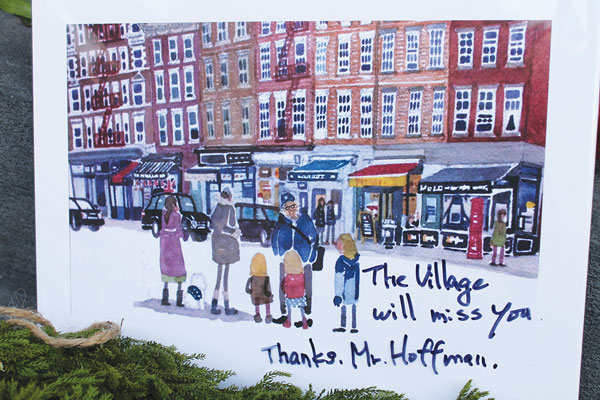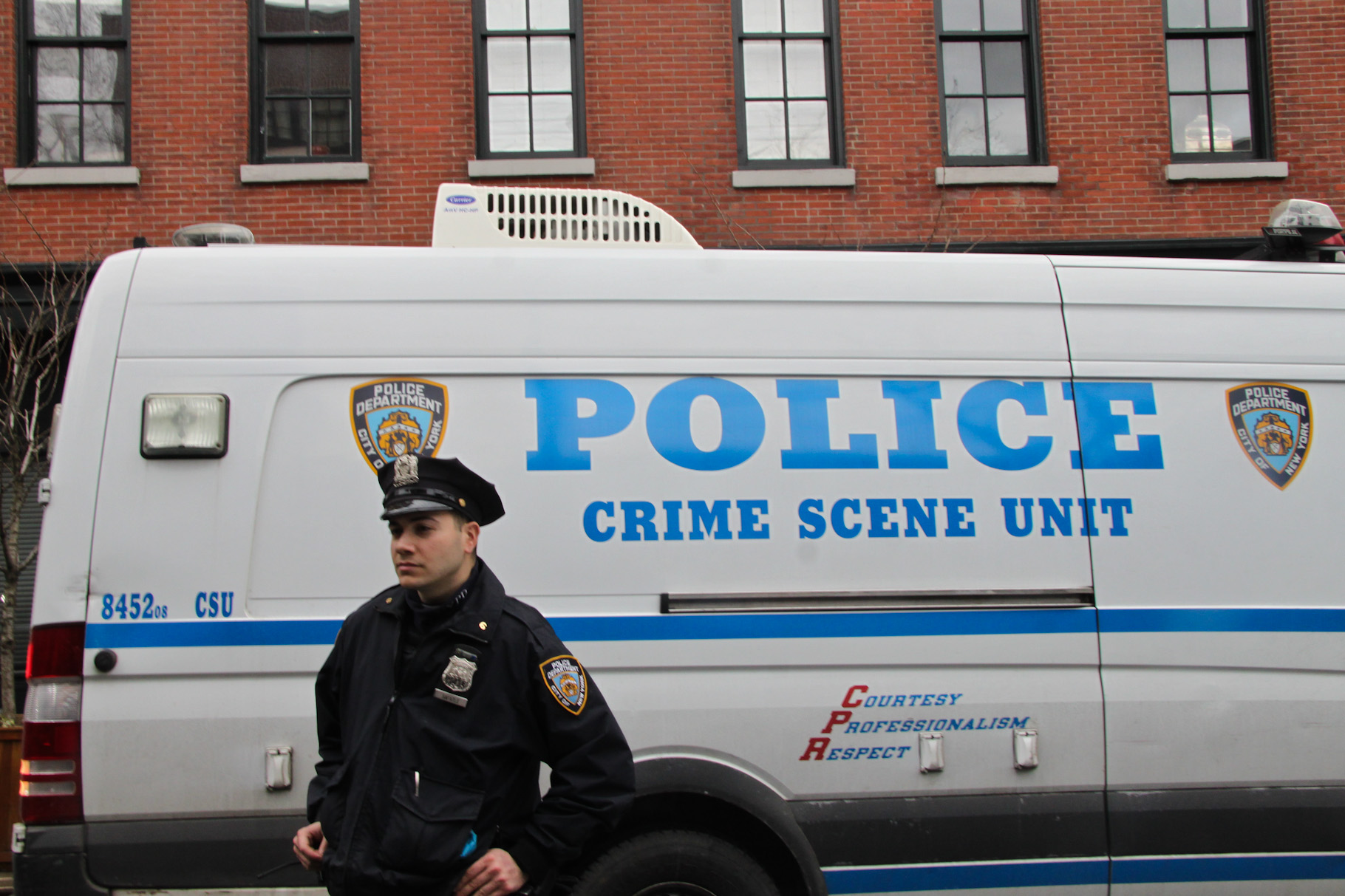
BY LINCOLN ANDERSON | It was early Tuesday afternoon, and fans and admirers of tragic actor Philip Seymour Hoffman were stopping by to pay tribute outside his West Village building, each in his or her own way.
Artist Kaz Morimoto stood writing on a watercolor painting he had done of Hoffman and his family — “The Village will miss you” — then placed it down among the flower bouquets and candles that had been left on the Bethune St. building’s front step. Then he squatted down and put his hands together in silent prayer, holding still that way for a full minute.
“I would always see him with his family,” the artist said, “and riding his bike. I’d wave to him.”
He just seemed like a good guy, Morimoto said.
A few steps away, in another artistic expression in Hoffman’s honor, Arrowe, 23, was strumming away on a guitar and feverishly belting out a song — “For Lester Bangs” — that he’d written the night before. The title referred to Hoffman’s role as the iconoclastic rock journalist in the movie “Almost Famous.”
I don’t know if I’ll be alive tomorrow
I don’t know if I’m alive today…
Suddenly, I hear the clocks ticking,
yeah, ticking in my head
and I know it’s going to be the end…
Addiction don’t see if you got a lot
of money… and f— TMZ!

“He was an inspiration to me,” said Arrowe. “I’m from New York. He was just like a real New Yorker. He didn’t care about the glamour.”
He said he was upset at the media’s coverage of Hoffman — particularly TMZ for showing photos of him passed out on an airplane. He also objected to those who say that the actor, since he was rich, could and should have easily overcome his habit by just getting the best help available.
Speaking of media, as he talked, an entire crew of “Entertainment Tonight” was camped out on the sidewalk across from the building.
Every few minutes someone else came by to take photos of the memorial. Christine Davis, from the Bronx, left a bouquet.
“I’m a distant relative of Robert Falls, who directed him in ‘Long Day’s Journey,’ ” she said. “I just was shocked by the news.”
Indeed, in a story that has shocked the entire world, the Academy Award-winning actor was found dead in his Bethune St. apartment Sunday morning, the victim of an apparent heroin overdose.
The Police Department issued a statement, saying that at around 11:36 a.m., police responded to a 911 call for “an aided male” inside 35 Bethune St., the Pickwick House.
“Upon arrival, officers located a 46-year-old male, unconscious and unresponsive, lying on the bathroom floor,” police said. “E.M.S. also responded and pronounced the male DOA at the scene. An investigation is ongoing by the N.Y.P.D. The Medical Examiner’s Office will determine the cause of death.” Police identified the deceased as Hoffman.
Media reports stated that the famed actor was found in his underwear, lying on his right side, with a needle still stuck in his left arm and two small glassine bags of heroin nearby. Several other empty heroin bags were reportedly also found in a trash bin in the apartment.

By Tuesday, though, it was reported that police had found as many as 70 small bags of dope, packaged for individual sale, in the apartment. Forty-nine bags were sealed, and 23 had been used. They were marked with dark lettering saying “Ace of Spades” or with a red ace of hearts stamp, street names for the drug. The bags reportedly sell for as little as $6 on the street.
The actor’s Bethune St. apartment was said to have been set up “like a shooting gallery.” Also said to have been found were two charred spoons — apparently used to cook the heroin before shooting it — 20 used hypodermic needles in a cup and a small amount of cocaine.
In addition, the New York Post on Tuesday further reported that police found in Hoffman’s unit an assortment of prescription pills, including Clonidine hydrochloride (a blood pressure medication), Buprenorphine (an addiction-treatment drug), Vyvanse (a drug for treating attention-deficit disorder), Hydroxyzine (an anti-anxiety drug) and Methocarbamol (a muscle relaxant).
Hoffman’s body was removed from the building around 6:40 p.m. Sunday. The M.E. will perform an autopsy and toxicology tests to determine the cause of death. Police checked to see if the heroin was laced with fentanyl, a powerful opiate that is more potentially dangerous than heroin alone, and has been linked to 22 fatal OD’s in Pennsylvania last month. But on Wednesday, it was reported initial tests found none of the additive.
On Sunday, Hoffman had failed to arrive at 9 a.m. to pick up his three children — Cooper, 10, Tallulah, 7, and Willa, 5 — on Jane St., where they lived with his longtime partner, Mimi O’Donnell, a costume designer. O’Donnell called Isabella Wing-Davey, Hoffman’s personal assistant, who went with screenwriter David Katz and found Hoffman’s lifeless body. Police said he had been dead for some hours.
In his early 20s Hoffman had struggled with drugs and alcohol, and recently had relapsed. In 2006, he described his battle with substance abuse on “60 Minutes.” TMZ reported that he had fallen off the wagon last year and had started taking prescription pills and was slipping into snorting heroin. He revealed he had done a 10-day rehab stint.

Police are investigating where Hoffman got his drugs.
On Wednesday, it was reported that just after 8 p.m. on Sunday, Hoffman, “with two drug couriers” standing next to him,” had withdrawn $1,200 from the A.T.M. at the D’Agostino supermarket down the block from his place, and then handed the men $1,000 for heroin and coke. A witness and bank records were cited.
Earlier that evening he reportedly had a cheeseburger and no alcohol at Automatic Slim’s with two people in what appeared to be a business dinner. The Post reported that on Jan. 24 he had attended an Alcoholics Anonymous meeting at the Perry Street Workshop, where he had been going to A.A. for more than 20 years.
The Post said that between Thursday and Sunday he had had stopped in at several other local eateries and bars, including Pizzetteria Brunetti, La Bonbonniere, Highlands pub, Chocolate Bar and The Standard Hotel.
Hoffman — who had been a West Village resident for years — moved into the Bethune St. apartment about three or four months ago, while O’Donnell and his three kids continued to live on Jane St. O’Donnell reportedly had kicked him out after he started using again. Itʼs said that a few months ago he was spotted openly buying smack at a known drug den on Mott St.
Hoffman grew up in Rochester, N.Y., and went on to study acting at New York University’s Tisch School of the Arts.
He won the Oscar for best actor for “Capote” in 2005. Like a chameleon, he artfully immersed himself in a dizzying array of character types. Among some of the many other films in which he starred were “The Master,” “Moneyball,” “Doubt,” “Charlie Wilson’s War,” “Mission: Impossible III,” “The Big Lebowski” and “Boogie Nights.”
There was a huge amount of media gathered Sunday afternoon outside Hoffman’s building on Bethune St., between Greenwich and Washington Sts., where his fourth-floor apartment rented for close to $10,000 a month.
John Anderson, 43, a newspaper editor from Rochester, happened to be in town to watch the Super Bowl with his brother Michael, who used to live nearby and would have drinks with Hoffman at the White Horse Tavern.
“They had a little kinship,” he said. “It’s a small world.”
In fact, their mother taught a teenaged Hoffman acting at Rochester Area Performing Arts, or RAPA.
“She thought he was just a very talented actor,” Anderson recalled, “not necessarily that he would win an Oscar, but that he was going places.”
He said Hoffman grew up in one of the nicer Rochester suburbs, and attended Fairport High School. He added that the actor, in his Oscar acceptance speech, gave a shout-out to his hometown.
“Rochester is in mourning right now,” he said.
Anderson and his brother had met at the Corner Bistro on Sunday, and when he heard the news of Hoffman, he used his press pass to get past the police line on Bethune St., and filmed some video of the scene that he planned to upload for his newspaper chain.
Hoffman’s isn’t the only recent Downtown drug-related death of a famous Hollywood star to make headlines. In January 2008, Australian actor Heath Ledger accidentally OD’d on prescription drugs in his Soho apartment.
On Tuesday afternoon, Nick, the super at 35 Bethune St., was chip-chip-chipping away at the ice on the sidewalk around the entrance with a long pole with a flat metal tip. He’s worked there 17 years. The building is mostly condo, some rentals, he said. Hoffman’s apartment was a two-bedroom.
No, Nick said, no one called him when they found the body.
Asked what Hoffman had been like during his brief stay there, he said, “He was normal — normal guy.”
Gina Shamus, a senior artist from the Westbeth Artists Residence just across Washington St., was taking photos of the memorial.
She noted that in the 1970s she did arts and crafts with recovering addicts to help them rehab.
“They thought they had the answer back then,” she reflected. “At that time, methadone was coming in…but methadone wasn’t that different.”
She actually had not seen Hoffman’s movies, but that didn’t keep her from feeling the same thing that so many others have.
“I just felt so sad,” she said. “I didn’t even know him at all — but it just seemed like he had so much to give.”

















